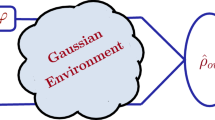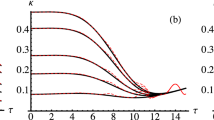Abstract
Quantum Gaussian channels play a key role in quantum information theory. In particular, the attenuation and amplification channels are useful to describe noise and decoherence effects on continuous variables systems. They are directly associated with the beam splitter and two-mode squeezing operations, which have operational relevance in quantum protocols with bosonic models. An important property of these channels is that they are Gaussian completely positive maps, and the action on a general input state depends on the parameters characterizing the channels. In this work, we study the coherence dynamics introduced by these channels on input Gaussian states. We derive explicit expressions for the coherence depending on the parameters describing the channels. By assuming a displaced thermal state with initial coherence as input state, for the attenuation case it is observed a revival of the coherence as a function of the transmissivity coefficient, whereas for the amplification channel the coherence reaches asymptotic values depending on the gain coefficient. Further, we obtain the entropy production for these classes of operations, showing that it can be reduced by controlling the parameters involved. We write a simple expression for computing the entropy production due to the coherence for both channels. This can be useful to simulate many processes in quantum thermodynamics, as finite-time driving on bosonic modes.





Similar content being viewed by others
Data Availability Statement
This manuscript has associated data in a data repository. [Authors’ comment: All the data generated during this study are contained in this article.]
References
X.-B. Wang, T. Hiroshima, A. Tomita, M. Hayashi, Quantum information with Gaussian states. Phys. Rep. 448, 1 (2007)
C. Weedbrook, S. Pirandola, R. García-Patrón, N.J. Cerf, T.C. Ralph, J.H. Shapiro, S. Lloyd, Gaussian quantum information. Rev. Mod. Phys. 84, 621 (2012)
G. Adesso, S. Ragy, A.R. Lee, Continuous variable quantum information: Gaussian states and beyond. Open Syst. Inf. Dyn. 21, 1440001 (2014)
K. Marshall, D.F.V. James, A. Paler, H.-K. Lau, Universal quantum computing with thermal state bosonic systems. Phys. Rev. A 99, 032345 (2019)
C. Macchiavello, A. Riccardi, M.F. Sacchi, Quantum thermodynamics of two bosonic systems. Phys. Rev. A 101, 062326 (2020)
R. Kosloff, Y. Rezek, The Quantum Harmonic Otto Cycle. Entropy 19, 4 (2017)
G. De Chiara et al., Reconciliation of quantum local master equations with thermodynamics. New J. Phys. 20, 113024 (2018)
A. Serafini, Quantum Continuous Variables. A Primer of Theoretical Methods (CRC Press, Boca Raton, 2017)
M. Jarzyna, Classical capacity per unit cost for quantum channels. Phys. Rev. A 96, 032340 (2017)
H. Qi, M.M. Wilde, Capacities of quantum amplifier channels. Phys. Rev. A 95, 012339 (2017)
S.N. Filippov, M. Ziman, Entanglement sensitivity to signal attenuation and amplification. Phys. Rev. A 90, 010301(R) (2014)
L. Ruppert, C. Peuntinger, B. Heim, K. Günthner, V.C. Usenko, D. Elser, G. Leuchs, R. Filip, C. Marquardt, Fading channel estimation for free-space continuous-variable secure quantum communication. New J. Phys. 21, 123036 (2019)
R. Blandino, A. Leverrier, M. Barbieri, J. Etesse, P. Grangier, R. Tualle-Brouri, Improving the maximum transmission distance of continuous-variable quantum key distribution using a noiseless amplifier. Phys. Rev. A 86, 012327 (2012)
S.L. Braunstein, N.J. Cerf, S. Iblisdir, P. van Loock, S. Massar, Optimal Cloning of Coherent States with a Linear Amplifier and Beam Splitters. Phys. Rev. Lett. 86, 4938 (2001)
P. Liuzzo-Scorpo, W. Roga, L.A.M. Souza, N.K. Bernardes, G. Adesso, Non-Markovianity Hierarchy of Gaussian Processes and Quantum Amplification. Phys. Rev. Lett. 118, 050401 (2017)
S. Kallush, A. Aroch, R. Kosloff, Quantifying the unitary generation of coherence from thermal quantum systems. Entropy 21, 8 (2019)
P.A. Camati, J.F.G. Santos, R.M. Serra, Coherence effects in the performance of the quantum Otto heat engine. Phys. Rev. A 99, 062103 (2019)
L.P. García-Pintos, A. Hamma, A. del Campo, Fluctuations in Extractable Work Bound the Charging Power of Quantum Batteries. Phys. Rev. A 125, 040601 (2020)
Y. Rezek, Reflections on Friction in quantum mechanics. Entropy 12, 1885 (2010)
F. Plastina, A. Alecce, T.J.G. Apollaro, G. Falcone, G. Francica, F. Galve, N. Lo Gullo, R. Zambrini, Irreversible work and inner friction in quantum thermodynamic processes. Phys. Rev. Lett. 113, 260601 (2014)
J.P. Santos, L.C. Céleri, G.T. Landi, M. Paternostro, The role of quantum coherence in non-equilibrium entropy production. npj Quantum Inf. 5, 23 (2019)
G. Francica, J. Goold, F. Plastina, The role of coherence in the non-equilibrium thermodynamics of quantum systems. Phys. Rev. E 99, 042105 (2019)
C. Datta, S. Sazim, A.K. Pati, P. Agrawal, Coherence of quantum channels. Annals Phys. 397, 243 (2018)
J. Xu, Coherence of quantum channels. Phys. Rev. A 100, 052311 (2019)
D.F. Walls, G.J. Milburn, Quantum Optics (Springer, Berlin, 2008)
L. Ortiz-Gutiérrez, B. Gabrielly, L.F. Muñoz, K.T. Pereira, J.G. Filgueiras, A.S. Villar, Continuous variables quantum computation over the vibrational modes of a single trapped ion. Opt. Commun. 397, 166 (2017)
T. Baumgratz, M. Cramer, M.B. Plenio, Quantifying coherence. Phys. Rev. Lett. 113, 140401 (2014)
A. Winter, D. Yang, Operational resource theory of coherence. Phys. Rev. Lett. 116, 120404 (2016)
K.B. Dana, M.G. Díaz, M. Mejatty, A. Winter, Resource theory of coherence: beyond states. Phys. Rev. A 95, 062327 (2017)
T.C. Ralph, A. Gilchrist, G.J. Milburn, W.J. Munro, S. Glancy, Quantum computation with optical coherent states. Phys. Rev. A 68, 042319 (2003)
J. Joo, W.J. Munro, T.P. Spiller, Quantum metrology with entangled coherent states. Phys. Rev. Lett. 107, 083601 (2011)
J. Xu, Quantifying coherence of Gaussian states. Phys. Rev. A 93, 032111 (2016)
A.M. Zagoskin, S. Savelév, Franco Nori, F.V. Kusmartsev, Squeezing as the source of inefficiency in the quantum Otto cycle. Phys. Rev. A 86, 014501 (2012)
F. Chen, Yi. Gao, M. Galperin, Molecular heat engines: quantum coherence effects. Entropy 19, 472 (2017)
F.H. Kamin, F.T. Tabesh, S. Salimi, F. Kheirandish, The resource theory of coherence for quantum channels. Quantum Inf. Process. 19, 210 (2020)
S. Gherardini, M.M. Müller, A. Trombettoni, S. Ruffo, F. Caruso, Reconstructing quantum entropy production to probe irreversibility and correlations. Quantum Sci. Tech. 3, 3 (2018)
S. Deffner, E. Lutz, Nonequilibrium entropy production for open quantum systems. Phys. Rev. Lett. 107, 140404 (2011)
H.-P. Breuer, F. Petruccione, The Theory of Open Quantum Systems (Oxford University Press Inc, New York, 2003)
Acknowledgements
Jonas F. G. Santos acknowledges São Paulo Research Grant No. 2019/04184-5, for support. Carlos H. S. Vieira acknowledges CAPES (Brazil) for support. The authors acknowledge Federal University of ABC for support.
Author information
Authors and Affiliations
Corresponding author
Appendix: Entropy production
Appendix: Entropy production
Although simple, here we derive the expression in Eq. (36). As mentioned in main text, the protocol is composed of two parts. The Gaussian input state passes through an attenuation (amplification) channel and then thermalizes with a Markovian thermal reservoir with inverse temperature \(\beta \) and average number of photons \(\bar{N}\). The entropy production of a unitary process followed by a thermalization can be written as [17]
where \(\rho _{\tau _{1}}\)is the state after the unitary transformation, \(\rho _{\tau _{2}}\) is the state during the thermalization process, and \(\rho _{\tau _{1}}^{\mathrm{eq,h}}\) is the reference thermal state associated with the thermal reservoir. As the reference state is thermal the relative entropy can be rewritten as \(S(\rho _{t}||\rho _{t}^{\mathrm{eq,h}})=\beta \left[ {\mathcal {U}}(\rho _{t})-F_{t}^{\mathrm{eq}}\right] -S(\rho _{t})\), with \({\mathcal {U}}(\rho _{t})\) and \(F_{t}^{\mathrm{eq}}\) the internal energy of the system and the free energy, respectively. By manipulating, we obtain
To complete, for Gaussian states the internal energy can be written in terms of the covariance matrix, i.e.,
With this, for Gaussian states the entropy production can be completely characterized by the covariance matrix of the state.
Rights and permissions
About this article
Cite this article
Santos, J.F.G., Vieira, C.H.S. Coherence dynamics induced by attenuation and amplification Gaussian channels. Eur. Phys. J. Plus 136, 323 (2021). https://doi.org/10.1140/epjp/s13360-021-01305-2
Received:
Accepted:
Published:
DOI: https://doi.org/10.1140/epjp/s13360-021-01305-2




